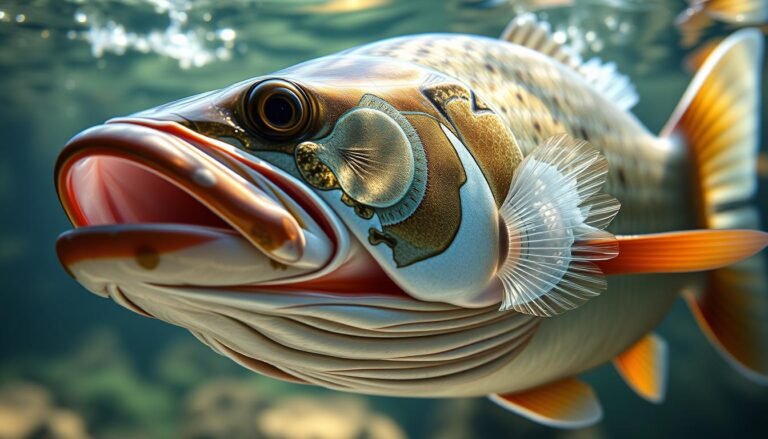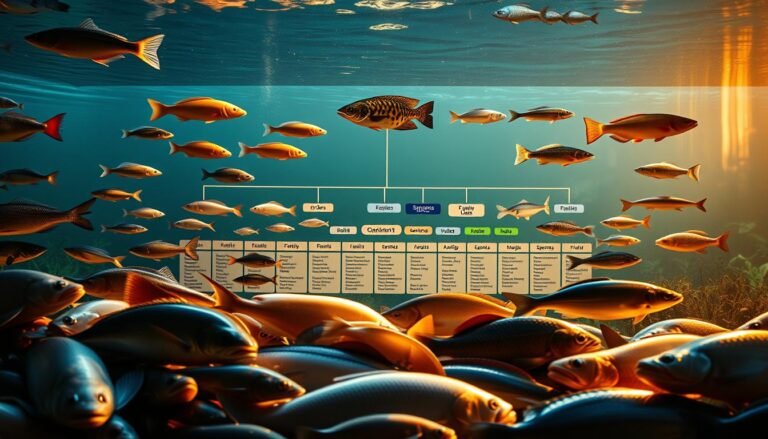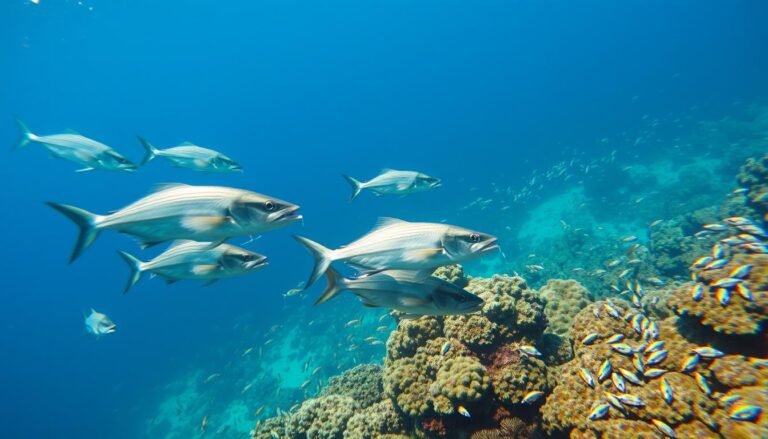Fish migration is a complex and fascinating phenomenon where various species travel long distances for reasons such as spawning, feeding, and escaping harsh environmental conditions.
Many species migrate on a regular basis, with some traveling thousands of kilometers each year. This remarkable journey is crucial for the survival of many aquatic species and plays a significant role in maintaining the balance of the aquatic ecosystem.
Understanding fish movement patterns can provide valuable insights into the health of our oceans and the impact of environmental changes on marine life.
Key Takeaways
- Fish migrate for various reasons including spawning and feeding.
- Some species travel thousands of kilometers annually.
- Fish migration is crucial for the aquatic ecosystem’s balance.
- Understanding fish movement patterns helps in assessing ocean health.
- Environmental changes significantly impact marine life migration patterns.
The Fascinating World of Fish Migration
The fascinating world of fish migration is characterized by a wide range of movement patterns, each with its unique ecological significance. Fish migration patterns vary greatly among species, with some fish migrating vertically in the water column daily, while others make long-distance journeys between freshwater and saltwater environments.
Defining Fish Migration Patterns
Fish migration is not a uniform behavior; it encompasses various patterns, including diadromous, potamodromous, and oceanodromous migrations. Diadromous migration involves movement between freshwater and saltwater, while potamodromous migration occurs entirely within freshwater systems. Understanding these patterns is crucial for managing fish populations effectively.
The Ecological Significance of Fish Movement
Fish migration plays a vital role in maintaining the ecological balance of aquatic ecosystems. As fish move through different environments, they contribute to nutrient cycling and help maintain the structure of their ecosystems. According to a study, “the migration of fish can significantly impact the nutrient dynamics of ecosystems, supporting the overall health of aquatic environments”
“the migration of fish can significantly impact the nutrient dynamics of ecosystems, supporting the overall health of aquatic environments.”
Moreover, fish migration supports biodiversity by facilitating the exchange of genetic material between populations.
By examining the ecological significance of fish movement, we can better appreciate the complex interactions within aquatic ecosystems and the importance of preserving these natural processes.
What Is Fish Migration? Understanding the Basics
Delving into the world of fish migration reveals the remarkable journeys that many fish undertake, driven by instinct and necessity. Fish migration is a vital aspect of the life cycle of many aquatic species, playing a crucial role in maintaining the balance of ecosystems.

The Science Behind Fish Travel Behaviour
Fish migration is driven by a combination of genetic predisposition, environmental cues, and physiological needs. Research has shown that many fish species have an innate ability to navigate, which is influenced by factors such as water temperature, salinity, and the presence of certain chemical cues. Understanding the science behind fish travel behaviour is essential for appreciating the complexity of their migratory patterns.
Distinguishing Migration from Other Fish Movements
It’s crucial to distinguish between migratory behaviour and other types of fish movement. While migration refers to the seasonal or periodic movement of fish between different habitats, other movements may be driven by factors such as food availability or predator avoidance. By understanding the differences between these movements, researchers and conservationists can better manage fish populations and protect their habitats.
By grasping the fundamentals of fish migration, we can gain a deeper appreciation for the intricate dynamics of aquatic ecosystems and the remarkable adaptability of fish species.
Types of Fish Migration Patterns
Understanding fish migration patterns is crucial for appreciating the intricate lives of fish and their interactions with different environments. Fish exhibit a wide range of migration patterns, which are primarily categorized based on the type of water they migrate between or within.
Diadromous Migration: Between Fresh and Salt Water
Diadromous migration involves the movement of fish between freshwater and saltwater environments. This category is further divided into anadromous and catadromous migrations.
Anadromous Migration
Anadromous fish migrate from saltwater to freshwater to spawn. A well-known example is the salmon, which travels upstream to reach its spawning grounds. This journey is often fraught with challenges, including navigating through dams and avoiding predators.
Catadromous Migration
Catadromous fish, on the other hand, migrate from freshwater to saltwater to spawn. The eel is a classic example of a catadromous migrant, traveling long distances to spawn in the ocean.
Potamodromous Migration: Within Freshwater Systems
Potamodromous migration refers to the movement of fish entirely within freshwater systems. This type of migration is often associated with changes in water levels, availability of food, or spawning requirements. For instance, some species of trout migrate within river systems in search of suitable spawning grounds or food-rich areas.
Oceanodromous Migration: Within Marine Environments
Oceanodromous migration occurs within marine environments, where fish migrate over long distances in search of food, suitable spawning grounds, or to escape harsh environmental conditions. Tuna and mackerel are examples of oceanodromous migrants, traveling vast distances across ocean basins.
These diverse migration patterns highlight the complex and fascinating behaviors of fish, driven by a variety of ecological and physiological needs. Understanding these patterns is essential for effective conservation and management of fish populations.
Why Do Fish Migrate? The Driving Forces
Understanding why fish migrate involves examining the key drivers behind this behavior. Fish migration is a complex phenomenon influenced by various factors that are crucial for the survival and success of migratory fish species.

Spawning and Reproduction
One of the primary reasons fish migrate is for spawning and reproduction. Many species travel long distances to reach specific breeding grounds, ensuring the continuation of their genetic lineage. For example, salmon migrate upstream to spawn in the gravelly streams where they were born.
Feeding Opportunities
Fish also migrate to exploit feeding opportunities in different habitats. Some species move to areas rich in food during certain times of the year, allowing them to grow and build energy reserves. For instance, many marine species migrate to nutrient-rich waters during plankton blooms.
Environmental Conditions and Seasonal Changes
Environmental conditions and seasonal changes significantly influence fish migration patterns. Changes in water temperature, salinity, and other environmental factors can trigger migrations. For example, some fish species migrate to deeper waters during winter to avoid harsh surface conditions.
| Driving Force | Description | Example |
|---|---|---|
| Spawning and Reproduction | Migration to specific breeding grounds | Salmon migrating upstream |
| Feeding Opportunities | Exploiting food-rich areas | Marine species moving to nutrient-rich waters |
| Environmental Conditions | Responding to changes in water conditions | Fish moving to deeper waters in winter |
How Fish Navigate During Migration
Fish have evolved remarkable strategies to navigate during their migrations. The complex process involves various sensory mechanisms and cognitive abilities that enable fish to travel long distances with precision.
Sensory Mechanisms in Fish Navigation
Fish utilize multiple sensory systems to navigate. These include:
Magnetic Field Detection
Some fish can detect the Earth’s magnetic field, which serves as a compass for orientation during migration.
Chemical Sensing and Olfaction
Chemical cues play a significant role in guiding fish. Olfactory signals help them identify spawning grounds and feeding areas.
Visual and Celestial Cues
Visual information, including celestial cues like the position of the sun or stars, also aids in navigation.
The Role of Memory and Learning
Memory and learning are crucial for fish navigation. Fish can remember specific locations and routes, which is essential for successful migration. Studies have shown that some species imprint on certain environmental cues during their early life stages, which later guide their migratory paths.
“The ability of fish to navigate during migration is a testament to their remarkable adaptability and the complex interplay of sensory and cognitive processes.”
A summary of the key navigational mechanisms used by fish during migration is provided in the following table:
| Navigational Mechanism | Description | Example |
|---|---|---|
| Magnetic Field Detection | Using Earth’s magnetic field for orientation | Salmon using magnetic fields to navigate |
| Chemical Sensing and Olfaction | Guided by chemical cues and smells | Eels migrating based on olfactory signals |
| Visual and Celestial Cues | Using visual information and celestial bodies for direction | Tuna navigating using the sun’s position |
Iconic Migratory Fish Species of Australia
From the coastal waters to the river systems, Australia is home to a variety of fish that migrate across different habitats. These migrations are crucial for the survival of the species and the balance of the ecosystems they inhabit.
Barramundi: Australia’s Prized Catadromous Fish
The barramundi is a highly prized species in Australia, known for its catadromous migration. Born in freshwater, barramundi migrate to saltwater environments to mature before returning to freshwater to spawn. This complex life cycle is a remarkable example of spawning migration in fish.
Australian Bass and Their Seasonal Journeys
Australian bass are another significant migratory species, undertaking seasonal journeys between freshwater and estuarine environments. Their migrations are closely linked to environmental cues, such as changes in water temperature and flow, highlighting the intricate relationship between these fish and their ecosystems.
Murray Cod and Golden Perch Migration in River Systems
Murray cod and Golden perch are iconic species within Australia’s river systems. While they are primarily freshwater residents, they undertake significant migrations for spawning and feeding. These movements are vital for maintaining genetic diversity and population health, demonstrating the importance of connectivity in riverine ecosystems.
In conclusion, the migratory fish species of Australia, including barramundi, Australian bass, Murray cod, and Golden perch, play a vital role in the country’s aquatic ecosystems. Understanding and conserving these species is essential for maintaining the health and biodiversity of Australia’s waterways.
Global Champions of Long-Distance Fish Migration
Some fish species are renowned for their extraordinary long-distance migrations, showcasing nature’s remarkable adaptability. These migrations are not only fascinating but also crucial for the survival of these species and the ecosystems they inhabit.
Pacific Salmon: The Ultimate Spawning Journey
Pacific Salmon are iconic for their long-distance migration from the ocean back to their natal streams to spawn. This journey can be thousands of kilometers long and is fraught with challenges, including navigating through treacherous waters and avoiding predators. Their determination is a testament to their resilience and the importance of their spawning grounds.
European Eels: A 6,000 km Mystery
European Eels migrate from their freshwater habitats to the Sargasso Sea, a journey of approximately 6,000 kilometers. The exact cues that guide them are still not fully understood, making their migration one of the most intriguing in the animal kingdom. Their long journey is crucial for their life cycle, as they spawn in the Sargasso Sea before dying.
Bluefin Tuna: Transoceanic Travellers
Bluefin Tuna are known for their transoceanic migrations, crossing entire ocean basins in search of food and suitable spawning grounds. These fish are capable of maintaining high speeds over long distances, making them one of the ocean’s top predators. Their migrations play a significant role in maintaining the balance of marine ecosystems.
| Species | Migration Distance | Purpose of Migration |
|---|---|---|
| Pacific Salmon | Up to 1,500 km | Spawning |
| European Eels | Approximately 6,000 km | Spawning |
| Bluefin Tuna | Transoceanic (thousands of km) | Feeding and Spawning |
Challenges Threatening Fish Migration Today
As we explore the complexities of fish migration, it becomes clear that numerous challenges are hindering these journeys. Fish migration is crucial for the survival of many aquatic species, and understanding these challenges is vital for conservation efforts.
Physical Barriers: Dams and Weirs
One of the significant challenges facing migratory fish is the presence of physical barriers such as dams and weirs. These structures can block traditional migration routes, preventing fish from reaching their spawning grounds or feeding areas. For instance, the construction of dams can alter fish movement patterns, forcing them to find alternative routes or face the risk of injury or death when attempting to pass through or over these barriers.
Climate Change Impacts on Migration Patterns
Climate change is another critical factor affecting spawning migration in fish. Rising water temperatures and altered flow regimes can disrupt the delicate timing of fish migrations, potentially leading to mismatches between fish arrival at spawning grounds and the availability of food resources. This can have cascading effects on entire ecosystems, highlighting the need for adaptive management strategies to mitigate these impacts.
Water Quality and Habitat Degradation
Water quality and habitat degradation also pose significant threats to fish migration. Pollution, sedimentation, and habitat destruction can degrade the quality of migration corridors and spawning grounds, making it difficult for fish to survive and reproduce. Efforts to improve water quality and restore habitats are essential for maintaining healthy fish populations and supporting their migratory behaviors.
In conclusion, the challenges facing fish migration today are multifaceted and require comprehensive conservation strategies. By addressing these issues, we can work towards preserving the intricate fish migration patterns that are vital for the health of our aquatic ecosystems.
Studying Fish Migration: Research Methods and Technologies
To comprehend the intricacies of fish migration, scientists utilize a variety of research methods and technologies. These approaches are crucial for understanding the complex behaviors and patterns exhibited by migratory fish species. By employing a range of techniques, researchers can gather comprehensive data on fish migration.
Traditional Tagging and Tracking Methods
Traditional tagging and tracking methods have been used for decades to study fish migration. These methods involve capturing fish, attaching a tag or identifier, and then releasing them back into the water. Later, when the fish is recaptured, the tag provides information on its migration route and distance traveled. Mark-recapture studies are a common application of this method, offering insights into fish movement patterns.
Modern Telemetry and Satellite Tracking
Modern telemetry and satellite tracking technologies have revolutionized the study of fish migration. These methods allow for real-time monitoring of fish movements over long distances. Acoustic telemetry, for example, uses sound waves to track fish equipped with acoustic transmitters. Satellite tracking, on the other hand, provides global coverage, enabling researchers to monitor fish migrations across entire ocean basins.
Environmental DNA (eDNA) Applications
Environmental DNA (eDNA) analysis is a relatively new tool in the study of fish migration. This method involves sampling water for DNA shed by fish, which can then be analyzed to identify species presence and abundance. eDNA applications are particularly useful for detecting rare or elusive species and can provide insights into fish migration patterns without the need for direct observation.
| Research Method | Description | Advantages |
|---|---|---|
| Traditional Tagging | Involves attaching a tag to a fish and releasing it | Provides direct data on migration routes and distances |
| Modern Telemetry | Uses acoustic or satellite tracking for real-time monitoring | Offers detailed, real-time data on fish movements |
| eDNA Analysis | Analyzes DNA in water samples to detect species presence | Non-invasive, useful for rare or elusive species |
Conservation Efforts for Migratory Fish in Australia
Protecting migratory fish in Australia requires a comprehensive approach, involving government initiatives and community engagement. The country’s unique biodiversity is underpinned by the health of its migratory fish populations, which play a crucial role in maintaining ecological balance.
Restoring Connectivity with Fishways
One of the significant challenges migratory fish face is navigating through river systems obstructed by dams and weirs. To address this, the construction of fishways and fish ladders has been a critical conservation strategy. These structures enable fish to migrate upstream, ensuring they can reach their spawning grounds. According to a study on fish passage facilities, the implementation of effective fishways can significantly enhance the migration success of species like the Australian bass (IntechOpen).
Protected Areas and Seasonal Restrictions
Establishing protected areas is another vital strategy for conserving migratory fish. These areas provide a safe haven for fish to spawn and grow without the pressure of fishing activities. Additionally, seasonal fishing restrictions help in managing fish populations sustainably, allowing species to migrate and spawn without disturbance.
Community Engagement in Conservation
Community-based conservation initiatives are also pivotal. By engaging local communities in conservation efforts, there is a greater awareness and understanding of the importance of protecting migratory fish. This includes initiatives like citizen science projects and community-led restoration of habitats.
| Conservation Measure | Objective | Benefit |
|---|---|---|
| Fishways and Fish Ladders | Restore connectivity | Enable upstream migration |
| Protected Areas | Protect habitats | Safeguard spawning grounds |
| Seasonal Fishing Restrictions | Manage fishing pressure | Allow undisturbed spawning |
As highlighted by a conservation expert, “Community involvement is key to the long-term success of conservation efforts for migratory fish.”
“The health of our rivers and the fish that inhabit them is a reflection of our broader environmental health.”
Conclusion: The Future of Fish Migration in a Changing World
Understanding what is fish migration is crucial in addressing the challenges faced by migratory fish populations. Spawning migration in fish, a critical aspect of their life cycle, is being impacted by climate change, habitat degradation, and human activities.
As discussed, various fish species migrate across different environments, from freshwater to saltwater, in search of food, suitable spawning grounds, and favorable environmental conditions. However, these migrations are being disrupted by physical barriers, changes in water quality, and habitat degradation.
To mitigate these impacts, continued research, conservation efforts, and community engagement are necessary. Initiatives such as fishways, protected areas, and seasonal fishing restrictions can help restore connectivity and ensure the long-term sustainability of migratory fish populations.
By working together to address these challenges, we can help preserve the fascinating world of fish migration for future generations.



